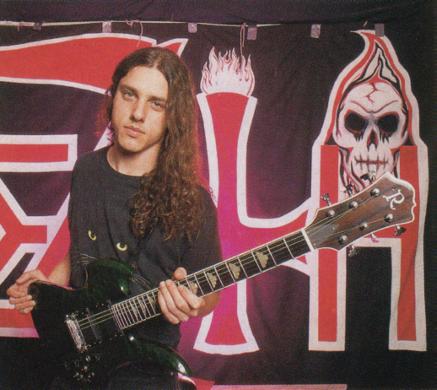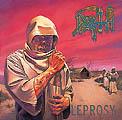| |
|
FROM
THE UNDERGROUND, TO THE CHARTS AND BACK:
The History of Death Metal
At the end of the
80's the heavy metal scene went through a revolution once and
for all. The classic dinosaurs like Maiden, Priest, Saxon, Def
Leppard or Helloween had hit creative lows, the glam scene was
dead and minimal inspiration was coming from thrash. On the
other hand two new movements arose in the underground: on one
side: the alternative Grunge-Rock-movement, on the other side:
death metal.
Death metal had already been
born in the early 80's. Who exactly invented this music style
is hardly to be argued nowadays. Personally I stumbled across
over the term death metal when Possessed put a song of the same
name on their debut disc Seven Churches, which appeared in 1985.
One year earlier however, in Florida, there were two bands,
Massacre and Death, that had recorded their first demos. With
their hellish, badly played yet cult noise, they secured the
first recordings regarded as "death metal."
|
Death metal nevertheless stayed totally underground for the coming
years. Chuck Schuldiner, with his legendary chapel Death already
got himself a record deal in the mid 80's and released the 1987
debut, Scream Bloody Gore. This album appeared at the perfect
time, because the lovers of extreme metal sounds had gone without
for quite some time. The golden days of Venom were long gone.
Possessed had reached their end, and even Motörhead (back
then one of the heaviest bands around) were not really showing
top form. It's no wonder Scream Bloody Gore came as a complete
shock and started a lively battle in the underground. On the smallest
labels, singles were being released of bands of the same sort.
In England the British radio moderator John Peel took the first
attempts to try to bring English noise combos to the vinyl market
through the John Peel sessions, and with Earache a firm was on
the Island that started with semi-professional distribution structures
to get debut pieces on the market from acts like Morbid Angel,
Entombed or Napalm Death. |

The Godfather of the scene: Chuck Schuldiner
(Death)
|
Now things really started going. Out of the American death metal
mecca Florida bands like Morbid Angel, Deicide, Obituary, Malevolent
Creation and Atheist started crawling out, soon joined by the
Buffalo Cannibal Corpse, while on the other side the Swedes formed
out of ancient death metal bands Nihilist and Carnage, new acts
like Unleashed, Dismember or even Entombed.
England followed well over
a year later after combos like Carcass, Napalm Death, Bolt Thrower
and Benediction, let go of their grind and crustcore roots and
went more and more into the direction of death metal. The movement
gained momentum, and top acts out of this scene could easily sell
40,000 pieces in Germany alone, Obituary even broke the 100,000
mark in America.
Bands out of Central Europe as
of yet limped a bit behind; certain was that next to the British
Earache label and the Dutch Roadrunner, mainly the German record
labels were being supportive to death metal and helped build
it. Century Media and Nuclear Blast put numerous acts on the
metal map and with that became successful rivals of the up till
then leading independent labels, which were ignoring this scene
completely. Pretty quickly in the heart of Europe also developed
a powerful band scene. Pestilence, Morgoth, Gorefest, Pungent
Stench, Massacra and Asphyx are merely a few names to be named
in this context.
Around the year 1993 the death
metal experienced its most commercially viable period, but as
often happens with good running trends, the market got flooded
with releases of mediocre profiteers. Record labels that missed
out on the opportunity in the beginning days were hoping to
get their share; new labels thought they could enter into the
death metal market. In short: the total saturation wasn't far
away and ultimately in the mid 90's the wheat was seperated
from the chaff. Many combos disappeared as quickly as they arised.
Others changed their style, just a few established bigs like
Morbid Angel, Cannibal Corpse, Hypocrisy, Bolt Thrower and Dismember
stayed loyal to death metal without making compromises.
However it would not take long
before death metal lived a renaissance again. While at the end
of the 90's black metal took the lead, for example in Göteborg
some sneaks rigged up the traditional death metal sound and
developed a quite melodic variant. Next to At the Gates, bands
like In Flames and Dark Tranquility can also be seen as pioneers.
Meanwhile in the USA a scene arised with bands with a strong
preference towards grind elements, but melted this together
with simple and affective groove-parts, Dying Fetus and Mortician
have to be named as advocates. And with Six Feet Under there
appears to be a group that has a large commercial potential.
This healthy reduction without any doubt, was very good for
the scene. In the beginning of the new millenium there's at
least a well balanced mixture of older scene veterans who still
can take care for new creative heights, and a very vital underground
with fresh ideas taking care of an important role for the death
metal once again.
|
|
|
 |
|
 |
| |
 RECORD MANIA
RECORD MANIA
~Leprosy~
place 112 of 300
Nowadays
Death is synonymous for a playful, progressive form
of death metal, making heavy demands on technique. But
that hasn't always been the case. The first two pieces
of the combo around the extremely obstinate band leader
Chuck Schuldiner, offer death metal in its most primitive
and comprehensable form. On the second piece of work
Leprosy Chuck Schuldiner brought this sound to perfection.
The guitarist /
singer / songwriter inflames an inferno of deadly riffs,
and the songs are arranged so that other instruments
are just being ornamental. Bassist Terry Butler merely
plays parallel with the guitar riffs, while drummer
Bill Andrews actually only has to concentrate on the
pure rhythm work on the snare, hi-hat and the bass drum;
sparkling breaks and fills are hardly to be heard. Whether
this was planned to work like this will probably remain
Schuldiners secret forever, but it certainly was very
effective.
Not for nothing Leprosy is one of the most influentual
classics of the death metal genre, evergreens like "Pull
The Plug", "Open Casket" or the title
track still are counted among the pillars of every Death
show, from which there will hopefully be many before
long - hoping that Chuck overcomes his severe illness
as soon as possible.
Frank Albrecht
|
|
 |
|
 |
|
|
|